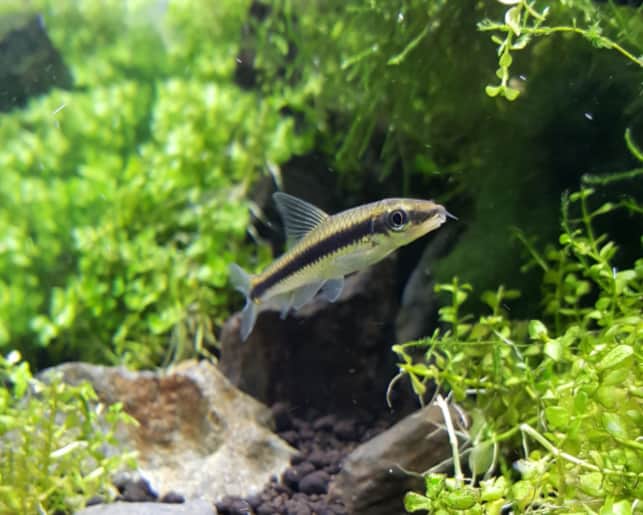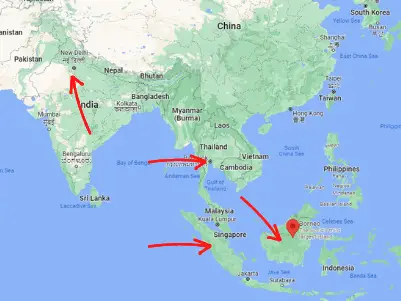The Flying Fox is mostly a peaceful fish. Its main aim in life is to eat as much algae as possible!
They are often mistaken for Siamese Algae Eaters as they look practically identical, and have the same characteristics as them. In fact, they are also known as True Flying Foxes, while anything else that looks like them is known as a False Flying fox.
I had trouble finding any images of the Flying Fox as they all seemed to be Siamese Algae Eaters. The main way to tell the difference is the fins on a Siamese Algae Eater are clear, whereas on a Flying Fox, they have some black shading on them. This is actually very pale when they are juveniles, and gets more pronounced as they reach maturity.
Read on for more information.
| Name: | Flying Fox |
| Scientific Name: | Epalzeorhynchos kalopterus |
| Family: | cyprinids |
| Origins: | Northern India, Thailand, Indonesia |
| Habitat: | fast flowing waters |
| Adult Length: | 15cms (6 inches) |
| Ideal Temperature: | 72-77 degrees Fahrenheit |
| Diet: | livefoods and algae |
| Life Expectancy: | 6-8 years |
| Behaviour & Characteristics: | peaceful, but territorial with its own kind |
| Ideal Tankmates: | any peaceful fish around the same size |
| Top, Middle or Bottom: | bottom |

Scientific Name:
The full scientific name for the Flying Fox fish is Epalzeorhynchos kalopterus. Epalzeorhynchos means shark, and in this case refers to their shark like shape, rather than them being an actual proper shark…
Family:
They are members of the Cyprinidae family of fish, which are more commonly known as the carp or minnow family.
Origins:
The Flying Fox originates from Eastern India, more specifically from the Bangladesh, Pakistan, Nepal and Myanmar regions.

Habitat:
The natural habitat of the Flying Fox is the fast flowing rivers in Northern India, Thailand, Borneo and Sumatra, with either rocky or sandy substrate. They do also have experience of slower water as well, when living in the flood plains.
They are used to being surrounded by plants so a heavily planted tank is always best for them.
Adult Length:
The typical adult length of a Flying Fox fish is approx 8-10cms when kept in a fish tank. They do seem to suffer from stunted growth when in captivity as they can reach up to around 15cms in their natural habitat.
The males tend to be slimmer with more vivid colours. The females can grow slightly larger and longer than their male counterparts and look slightly rounder in the belly.
Ideal Temperature:
The Flying Fox can easily cope with anywhere from 72-77 degrees Fahrenheit. They have been known to be fine with temperatures a touch under and over this as well.
Diet:
It’s all about the algae for the Flying Fox, they love it! They will spend hours cleaning your plants, although they don’t like red algae.
They also like live foods (fresh or frozen) and algae wafers. As with most fish, they won’t turn their nose up at a good quality flake as well.
Life Expectancy:
The average life expectancy if living in a tank is 6-8 years. However, people have reported their Flying Fox living to the ripe old age of 10. I suppose it is all about having optimum living conditions with little stress.
Behaviours & Characteristics:
Flying Fox fish are quite shy when in a community tank. They are best kept as a single or at most in a very small group. This is because, even though they are very peaceful, they aren’t when it comes to their own species, or anything that looks like them (step forward the near identical Siamese Algae Eater), they can become very territorial. A group of more than 4 will lead to aggressive behaviour amongst them, unless your tank is massive so there is lots of space for everyone.
Experienced aquarists say that it is virtually impossible to breed them in captivity, so, are probably not the right choice if you want baby fish.
Ideal Tankmates:
Ideal tankmates would be any other peaceful community fish. Fish like angelfish, danios, tetras and gouramis would be fine. They are also fine with other bottom dwelling fish, as long as there is enough space for everyone, so the Flying Fox doesn’t see the need to start bullying anyone for algae rich territory.
I wouldn’t put them with any other algae eating fish as it is just competition for food which could cause unrest and stress.
Top, Middle or Bottom:
Flying Fox fish spend all of their time at the bottom of the tank, in and around the plants, munching on algae.
Be aware though, that when they are first introduced to their new home, they do have a habit of trying to get out of it. Ensuring your tank lid is on will keep him safe until he has settled down into his new surroundings.
This video shows a Flying Fox hard at work on the plants at the bottom of his tank. It is quite mesmerising watching him at work!

